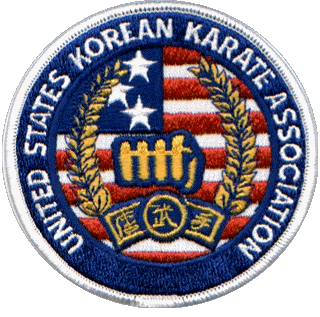 |
|||||||||||||||||||||||||||||||||||||||||||||
|
|
|||||||||||||||||||||||||||||||||||||||||||||
 |
|
For informational purposes, here is an explanation of the original Tang Soo Do - MDK crest. We should be familiar with it because it blends with the philosophy of our art. As a whole, the crest symbolizes the spreading of Tang Soo Do throughout Korea and then across the oceans to the other six continents of the world. 1. The fourteen green laurel leaves (on each side), represents the fourteen provinces of Korea and the advancement of peace (and the green belts). 2. The six red berries total to represent the six continents besides Asia (Korea), the fruitful result of training (and the red belts), the red color comes from the Yang. 3. The gold fist represents justice and honor. 4. The deep blue color of the background (or the scroll) represents the three oceans (and the blue belts). The blue comes from the Um or the Yin. The (midnight) blue and black belts are synonymous. 5. The character on the left of the circle is the Chinese word "Tang," referring to the Chinese influence (and possibly the Tang Dynasty) for our martial art; the character on the right of the circle is the Chinese word "Soo," meaning hand; the middle character is the Chinese word "Moo," which means martial or military. It is interesting to note that the character Moo is comprised of two other Chinese characters. The first is "sword" or "spear" (meaning fighting or war) and the second is "to stop" or "prevention" or "unwilling." Together, the word "military" (Moo) looks like "stop spear" and means to stop fighting or prevent war or to not want war. It is important to understand the significance of the character "Moo." The objective of Tang Soo Do is to be victorious without having to fight or go to war. However, once one has no other choice but to defend himself, he must be victorious even against the greatest of odds. This is the basic ideology of most martial arts. There are those who, at first, may not understand how learning to fight and defend oneself can prevent war and fighting. As one trains and realizes that being the toughest bully or always having to win is not important in the large scheme of life, this ideology becomes more obvious. One learns the "art of fighting without fighting." One finds out that winning (even at tournaments) may not be the most satisfying outcome, but that knowing one has performed to the best of their own ability is. |
| [Home] [Master Floyd Soo] [Self Defense] [Club Information] [Art & Founder] [Tang Soo Do Info] [History] [Philosophy] [Club Rules] [Procedures] [Terminology] [Bowing & Respect] [General Etiquette] [Crest Symbolism] [Sounding Off] [Belt Ranks] [1 & 3 Steps] [Free Fighting] [Forms] [Uniform] [Current Events] [Photo Album 1] [Photo Album 2] [Photo Album 3] [Photo Album 4] [Photo Album 5] [Photo Album 6] [Photo Album 7] [Photo Album 8] [Photo Album 9] [Photo Album 10] [Photo Album 11] [Photo Album 2012] [Photo Album BB Test] [Of Interest] [Inspiration] [Testimonials] [Class Schedule] [Pontiac Class] [Goodies] [Members Only] [Contact us & Links] |
 |